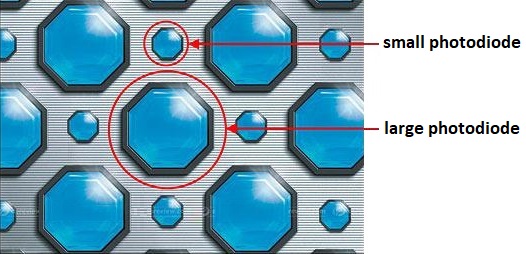SILIAX
Welcome to Siliax. An innovative enterprise in opto-electronics.
Siliax started up on 24 October 2016.
The main purpose of Siliax is to innovate, develop and commercialise a picture sensor & cameras with unprecedented dynamic range and pixel depth.
The project of Siliax is named Ladewifin which stands for "LArge pixel DEpth, WIde dynamic range & high SENsibility CMOS camera".
Ladewifn’s objective is prove that world records in digital photography:
-
200 dB dynamic range,
-
23 bits/pixel/color pixel depth (floating point),
-
98% fill-in ratio (for terrestrial applications : where microlenses are possible),
-
0,01 ≤ frame rate range ≤ 500 Hz and eventually wider, depending on the price.
can be broken using an innovative architecture on the top of TRL 3-4 European emerging IC technologies.
In a classic dual-pixel sensor, as on this picture,

-
the photodiodes have 2 different sizes,
-
the DAC have classic resolutions (between 8 & 14 bits / photodiode / color),
-
one photon can’t hit 2 photodiodes,
-
------------------------------------- = 12 approximately .
A LADEWIFIN picture sensor would have the equivalent performances BUT as if
-
the photodiodes would have 8 different sizes,
-
a single photon may hit the 8 photodiodes making one pixel,
-
with 20 bits / pixel / photodiode DAC (... and 8 photodiodes / pixel),
-
------------------------------------- = 1 000 000 (magnitude of order).
The magnitude of order of other features are expected to reach:
-
15 µm ≤ pixel pitch ≤ 29 µm
-
71% ≤ fill-in-ratio ≤ 91%
-
Diagonal ≤ 6 inches.
-
Approximative consumption = 150 femtoJoules / ( frame x mm² ).
-
Approximative weight = 2 milligrams / mm²
-
external driver unit's minimal (& approximative) requirements :
Ladewifin won’t research and innovate only the sensor but the whole camera that fits it.
No part of the Ladewifin camera is a copy-paste of any part of any other camera.
Ladewifin is a set of modular innovations that combine each other but they can also be used separately with other sensors, other lenses, other color splitter, other processing engines, other electronic devices. This will enable "à la carte" high-end or low-cost products.
For any answer about "How ?", fell free to get in touch.
Ladewifin dynamic range, pixel depth and sensibility can penetrate
-
real-time and differed-time applications,
-
streaming-movies and still-picture applications,
-
visible and invisible light applications,
-
color and monochromatic applications.
Ladewifin's impacted markets by end-user industry: space, vehicles factories, hospitals, emergency services, dentists, police banks, private users and defense.
Ladewifin's impacted market by applications : rocket observation (on the test bench and on the launch pad), driving assistance (facing sunlight, at night, in fog) , dental radiography, safety, night vision, media entertainment, anticipation of teract (facing sunlight, with human shield, with smoke).
Ladewifin innovations will provide maximum downward compatibility with current standards to maximize commercial impact.
-
29 x 29 mm² is an acceptable size for a high performance sensor.
-
The diagonal of this sensor is smaller than the diagonal of commercial 24 x 36 mm² sensors, insuring a maximum downward compatibility of the Ladewifin project.
-
It is also a size compatible with X-ray dentistry applications.
-
It accepts commercial frame rates of 25 or 30 Hz with 30 MHz clock signals from low cost FPGA.
-
1024 x 1024 pixels is compatible with FFT engines, PAL, SECAM and NTSC applications.
-
Frame rates from 0,01 to 500 Hz can be supported by the Ladewifin camera.
-
2,5 & 3,3 volts TTL logic compatible with maximum ESD immunity.
The Ladewifin camera can integrate future technological break-through at minimal costs:
-
as the latest technologies for integrated circuits will evolve,
-
as the technology of thinning back-side-illuminated wafers will evolve,
-
as the technology of micro-optics will evolve,
-
as the technologies for data processing will evolve ,
-
as the technology to dry the air (pushing back the dew point) will evolve,
-
as the production costs will decrease,
-
the LADEWIFIN project can take profit of it immediately.
Ladewifin is currently an abdstract concept on paper. Siliax is currently looking for funding opportunities for innovation to make Ladewifin a concrete reality.
© 2018 Siliax. All rights reserved.
